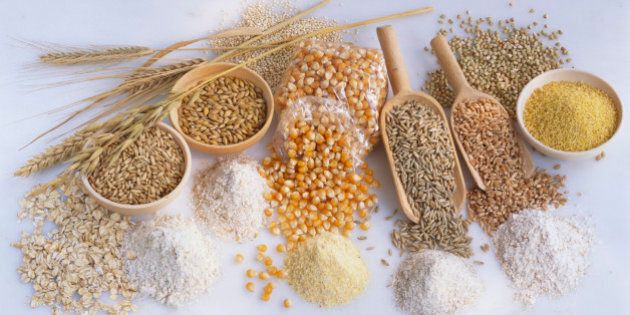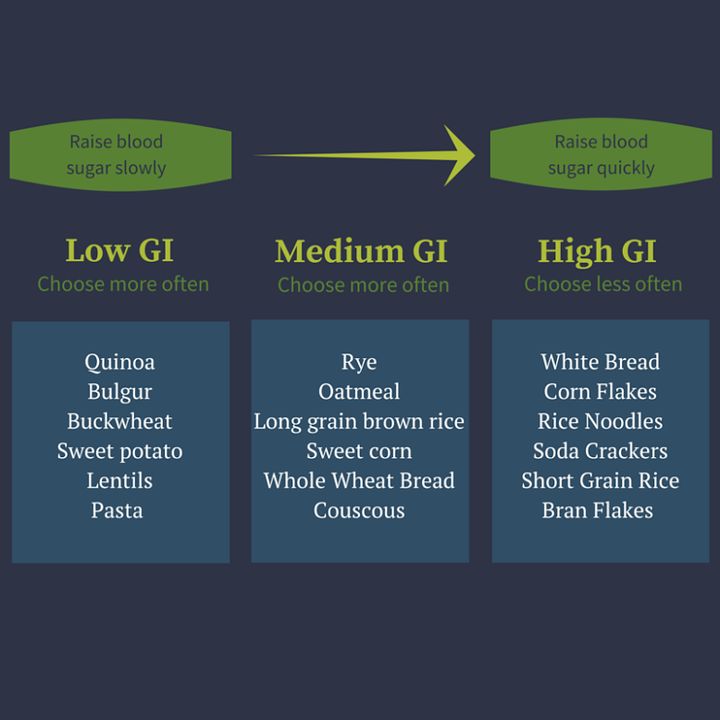
Have you walked into the grocery store lately and been overwhelmed about what bread to buy? Or what cereal to choose? There are so many options on the market that it has become more difficult to shop than ever before.
The rise of chronic diseases such as obesity, diabetes and heart disease motivates some people to become more careful about the food choices they make. If you are looking for an easy tool to help make healthy choices and help prevent the onset of chronic disease, the glycemic index has been shown to do just that.
The glycemic index is a scale that ranks carbohydrates (or starchy foods) by how much they raise blood sugar levels compared to eating a standard amount of pure sugar (glucose). The scale ranges from zero to 100. Low GI foods are 50 or less, Medium GI foods are 56-69, and High GI foods are 70 and above.
Here are some examples of low, medium and high GI foods high GI foods:

(Yep, that is no mistake! Semolina pasta, either white or whole grain, is a LOW glycemic index food)
Here are three reasons why including low glycemic index foods is important for your health:
They are high in fiber.
Low GI foods tend to be higher in fiber (when compared to high GI foods) and therefore digest more slowly in your body and help you feel full for longer. Including high fiber foods in your diet can help with the prevention and management of heart disease, obesity and diabetes as well as help with weight management.
They raise blood sugar slowly.
Low GI foods take longer to digest and so the nutrients are more slowly absorbed by the intestines. This causes a slow and steady rise in blood sugar followed by a gradual fall in blood sugar. This is in contrary to high GI foods, which are digested and absorbed rapidly by the intestines, leading to rapid highs and lows of blood sugar.
They can improve the function of the pancreas.
The pancreas does an amazing job at producing insulin when blood sugar is high. However, high GI foods cause rapid increases of sugar in the blood, which overworks the pancreas and actually weakens its ability to produce insulin overtime. Low GI foods have just the opposite effect -- the healthy gradual rise and fall of blood sugar can actually improve the function of the pancreas overtime and make it more efficient at producing insulin.
The good news is that you do not have to eliminate high GI foods completely in order to make a significant improvement to your health. Research has shown that changing just 60 per cent of your starches from high GI starches to low GI starches can significantly improve your diet.
Here are some tips on how to include more low GI foods into your diet:
1. Substitute one high GI food for one low GI food at each meal. For example, try oatmeal instead of cornflakes at breakfast. Or mix up your usual side dish by serving this fun new product that is a blend of quinoa and bulgur by PC Blue Menu.
2. Include fat and protein in your meal which can lower your glycemic response For example, throw some leftover chicken (or chickpeas) and olive oil into your couscous salad.
3. Plan your weekly menu around low GI foods such as barley and lentils. For example, try this barley risotto recipe (instead of one made with arborio rice) or use lentils in this quick and easy lentil soup.
4. Choose fewer processed meal and food options. For example, use long grain brown rice versus white short grain.
5. Combine high GI foods with low GI foods. For example, why not mix up the bread in your sandwich with one slice being your favourite kind and the other being a slice of whole grain.
Although there is no such thing as miracle foods, eating more low glycemic index foods will help you manage your health without the need to eliminate carbs from your diet. Bon appetit!
Co-written by Jenna West, nutrition intern
MORE ON HUFFPOST:
